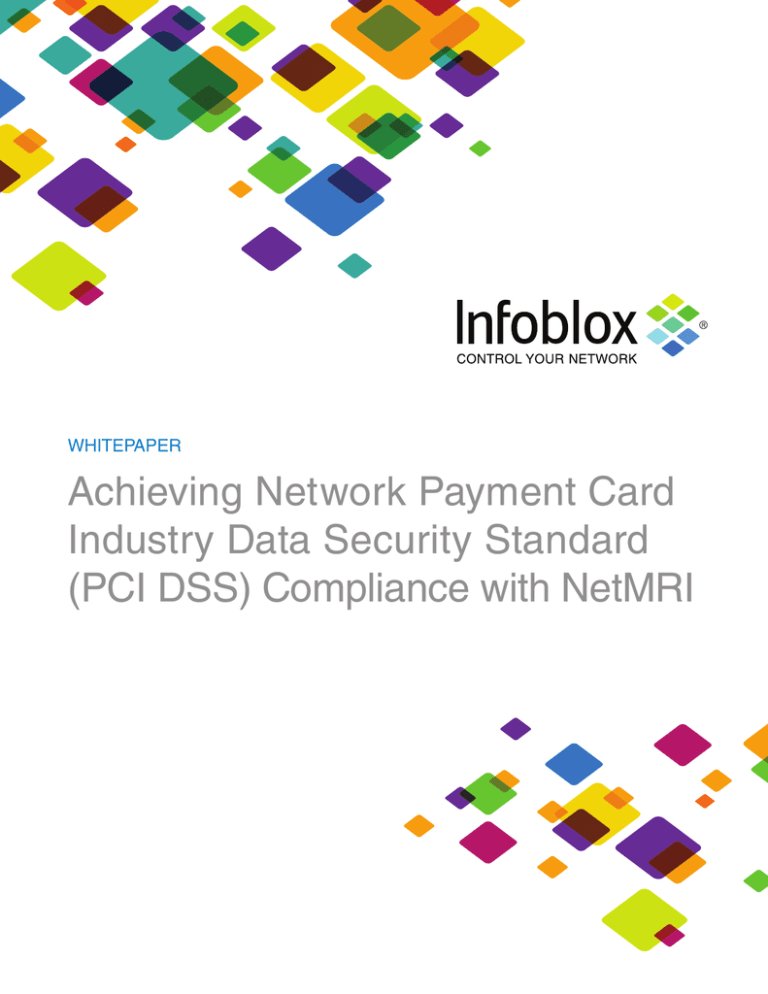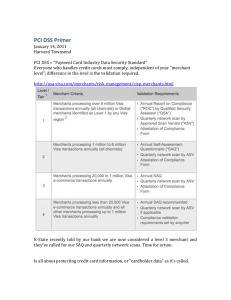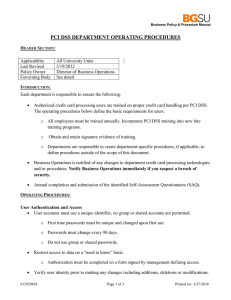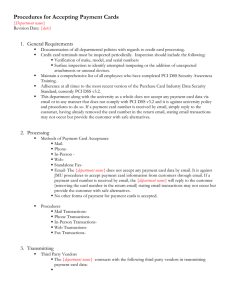
WHITEPAPER
Achieving Network Payment Card
Industry Data Security Standard
(PCI DSS) Compliance with NetMRI
About PCI DSS Compliance
The widespread use of debit and credit cards in retail transactions demands that
merchants, card processors, and payment companies secure and protect everincreasing amounts of cardholder data. Businesses can suffer catastrophic losses
of revenue and reputation if sensitive customer information is compromised by a
network security breach.
In 2005, the Payment Card Industry Data Security Standard (PCI DSS) was jointly
developed by the founding members of the PCI Security Standards Council—
American Express, Visa International, MasterCard Worldwide, Discover Financial
Services, and JCB International. They developed this standard so that all businesses
handling payment card information would have a comprehensive and uniform set of
requirements for protecting this data from theft and misuse.
PCI DSS offers a number of stringent IT infrastructure and security policy
requirements for all businesses that store, handle, access, and transfer cardholder
data. The standard applies equally to brick-and-mortar merchants as well as those
processing card payments online.
The greatest challenge to PCI DSS compliance resides in monitoring and managing
all its specific network requirements, which encompass security firewalls, access and
change controls, system updates and configuration changes, testing procedures, and
security policies.
This paper describes the ways that NetMRI can help you quickly achieve and maintain
PCI DSS compliance across your network. NetMRI can manage and monitor the
many demands of PCI DSS by automatically performing security audits, configuration
updates, and policy compliance verification on IT infrastructures of any size.
PCI DSS Requirements
PCI DSS requirements are written at a high level so that they can be applied to the
many different technical and processing systems used by large and small businesses.
The PCI Security Standards Council has issued six primary security objectives and
specific technical and policy-based requirements for achieving each of them. The
full list of requirements are contained in the PCI DSS, published by the PCI Security
Standards Council.
BUILD AND MAINTAIN A SECURE NETWORK
Requirement 1: Install and maintain a firewall configuration to protect cardholder data
Requirement 2: Do not use vendor-supplied defaults for system passwords and other security
parameters
PROTECT CARDHOLDER DATA
Requirement 3: Protect stored cardholder data
Requirement 4: Encrypt transmission of cardholder data across open, public networks
1
WHITEPAPER
Achieving PCI DSS Compliance with NetMRI
MAINTAIN A VULNERABILITY MANAGEMENT PROGRAM
Requirement 5: Use and regularly update anti-virus software
Requirement 6: Develop and maintain secure systems and applications
IMPLEMENT STRONG ACCESS CONTROL MEASURES
Requirement 7: Restrict access to cardholder data by business need-to-know
Requirement 8: Assign a unique ID to each person with computer access
Requirement 9: Restrict physical access to cardholder data
REGULARLY MONITOR AND TEST NETWORKS
Requirement 10: Track and monitor all access to network resources and cardholder data
Requirement 11: Regularly test security systems and processes
MAINTAIN AN INFORMATION SECURITY POLICY
Requirement 12: Maintain a policy that addresses information security
The Risks of Non-Compliance
PCI DSS compliance is not a legal requirement, nor is there an official certification
program to support it. However, the costs of non-compliance far outweigh those
associated with meeting the technical and policy requirements of the standard.
Visa, MasterCard, and American Express monitor compliance with the PCI DSS
requirements they have developed, and levy fines of up to $500,000 per incident on
merchants and service providers that fail to comply.
Even in the absence of fines, non-compliance becomes a drain on business.
Estimates show that, on average, an out-of-compliance network is 90% more
expensive to operate, costing over three million dollars annually for large companies.
Failure to comply with the standard can put businesses at risk of several other
consequences, including:
• Breaches or mishandling of customer card data, which can result in litigation or
damage to reputation
• Downtime and lost revenue caused by having to play “catch up” to address
compliance requirements
• Revocation of payment card transaction privileges owing to major or repeated
incidents of non-compliance
Achieving PCI DSS Compliance with NetMRI
Networks are becoming increasingly complex, and with such a variety of equipment
and software and all the interdependencies involved, businesses can barely manage
their networks without clearly-defined processes and principles. Implementing PCI
DSS technical and policy requirements adds yet another dimension of complexity
to manage.
2
The ability to monitor and manage a network is key to preventing business disruption
and financial loss, and any method, framework, or tool that can effectively reduce
downtime or network degradation is worthy of serious consideration. NetMRI network
change and configuration management solution is uniquely positioned to help
organizations comply with the PCI DSS with minimum preparation and investment.
NetMRI is a dedicated, stand alone network solution that automatically provides
proactive network discovery, identification of topology, and assessment of network
health and issues objectively, using industry best practices.
NetMRI is fully integrated and typically installs in 30 minutes. It plugs directly into
the network and operates non-intrusively, with browser-based reports that are
automatically generated based on issues—as they arise.
In addition to Configuration Policy Analysis and Network Auditing features essential for
PCI DSS compliance, NetMRI also provides network engineers with the analysis and
steps required to optimize the performance of the network and applications running on it.
Below are the network-specific requirements of the PCI DSS and corresponding NetMRI
capabilities.
Section 1.0 - Build and Maintain a Secure Network
For merchants, banks, and other businesses involved in storing, handling, and
transmitting cardholder data electronically, building and maintaining a secure network
must be the first priority. Establishing specific configuration policies is central to
ensuring network security, but monitoring and enforcing these policies across an everwidening, multi-vendor infrastructure poses a serious challenge.
NetMRI manages this challenge by automating the detection of configuration
changes not in compliance. An archiving feature stores all network configurations as
they change for easier troubleshooting. If you need to make configuration changes
throughout the entire network, the NetMRI Policy Enforcement function can span
multiple platforms from a variety of vendors. NetMRI puts configuration control back in
your hands, automatically.
SECTION
3
REQUIREMENT
NETMRI CAPABILITIES
1.1
Obtain and inspect firewall
configuration standards
NetMRI allows you to define Configuration Policy
Definitions based on available templates, and the
software will then automatically and continuously
check network elements against these established
policies. Notification is issued when policy is broken
on any network device, with the ability to drill down
to the details of any network device.
1.1.2
Build an accurate network
map (Using NetMRI
Topology data)
NetMRI automatically discovers network devices
and their connection topology and presents the
data in a graphical format, indicating network
neighbors, changes to devices, and devices out of
policy.
1.1.3
Verify firewall configuration
standards include
requirements DMZ and
intranet connections
NetMRI allows you to define and analyze
compliance by allowing you to define your own
configuration policies for network firewalls, and then
see elements that are outside of the established
guidelines.
WHITEPAPER
Achieving PCI DSS Compliance with NetMRI
SECTION
REQUIREMENT
NETMRI CAPABILITIES
1.1.5
Verify firewall configuration
standards include a list of
services/ports necessary
for business
NetMRI easily identifies ports in use on the network
devices, which can be used to create a list of
service/ports necessary for business.
1.1.8
Quarterly review of firewall
and router rule sets
NetMRI includes the capability to identify rule sets
that are not being used.
1.1.9
Establish and verify
configuration standards
for routers
NetMRI allows you to define and analyze
compliance by allowing you to define your own
configuration policies for routers, and be able to see
elements that are outside of the
established guidelines.
1.3.0
Examine firewall/router
configuration to verify
connections are restricted to
IP addresses within the DMZ
NetMRI allows you to define and analyze
compliance by allowing you to define your own
configuration policies for all network devices, and
then be able to see elements that are outside of the
established guidelines.
1.3.1
Verify that inbound Internet
traffic is limited to IP
addresses within the DMZ
NetMRI allows you to define configuration policies,
to support Internet traffic policies and be notified in
real-time when there is a problem.
1.3.2
Verify that internal addresses
cannot pass from the Internet
into the DMZ
NetMRI allows you to define and analyze policies
that will automatically detect such issues.
1.3.3
Verify that the firewall
performs stateful inspection
NetMRI allows you to define and analyze
compliance with your own configuration policy for
each network device, including the firewalls.
1.3.5
Verify that inbound and
outbound traffic is limited to
that which is necessary
NetMRI allows you to define configuration policies in
support of Internet traffic policies and be notified in
real-time when there
is a problem.
1.3.6
Secure and synchronize
router configuration files
for running and startup
configurations
NetMRI stores all router configurations and checks
start up configs against running configs and back-up
configs.
1.3.7
Verify that other traffic is
specifically denied
NetMRI allows you to define and analyze
compliance with your own configuration policy for
each network device.
1.4.1
Implement a DMZ to filter and
screen traffic
NetMRI allows you to define and analyze
compliance with your own configuration policy for
each network device.
1.4.2
Examine firewall/router
configurations that traffic from
cardholder applications can
only access DMZ
NetMRI allows you to define and analyze
compliance with your own configuration policy for
each network device.
Section 2.0 - Do Not Use Vendor-supplied Defaults for
System Passwords and Other Security Parameters
Vendor-supplied default passwords and other settings make it simpler to manage your
IT infrastructure, but the same convenience makes it easier for hackers to
compromise your network and the sensitive cardholder data residing on it. NetMRI
allows you to monitor and manage effective passwords for security parameters and
devices across the network, automatically checking for vendor supplied default
passwords and alerting you to their presence.
4
SECTION
REQUIREMENT
NETMRI CAPABILITIES
2.1
Change vendor-supplied
defaults and passwords
NetMRI allows you to define scripts to make
these changes and verify compliance. NetMRI
automatically detects default SNMP community
strings, as well as weak passwords as it attempts to
guess them, but does not automatically repeat this
detection once a valid password is known.
2.2
Develop configuration
standards for all
system components
NetMRI allows you to define and analyze
compliance with your own configuration policy
for each network device. The best practices and
vulnerabilities that are the basis for your policy must
be determined from other sources.
2.2.2
Disable all
unnecessary protocols
NetMRI allows you to define your own scripts that
make these changes and verify compliance.
2.2.3
Verify that common security
parameter settings are
included in the system
configuration standards
NetMRI allows you to define and analyze
compliance with your own configuration policy for
each network device.
Section 6.0 - Develop and Maintain Secure Systems and
Applications
To maintain effective network security and policy compliance, systems and
applications residing across your IT infrastructure often require regular security
patches and updates. NetMRI helps you establish and manage performance of these
processes. In addition, NetMRI detects potential security breaches by detecting open
ports in web-facing applications.
SECTION
REQUIREMENT
NETMRI CAPABILITIES
2.1
Examine that security
patches on network elements
have been applied within 30
days
NetMRI allows you to define your own scripts to
verify compliance. Knowledge of what patches
should be applied must come from other sources.
2.2
Ensure that web-facing
applications are protected by
detecting open ports
NetMRI can verify the presence of an applicationlayer firewall. However, the web-based applications
need to be manually identified.
Section 8.0 - Assign a Unique ID to Each Person
NetMRI can make changes to user accounts and passwords for network elements
and verify that they are policy compliant.
SECTION
5
REQUIREMENT
NETMRI CAPABILITIES
8.5.5
Remove inactive user
accounts at least every
90 days
NetMRI allows you to define custom scripts to make
user account changes on network elements and
verify compliance.
8.5.9
Change user passwords at
least every 90 days
NetMRI allows you to define rules that not only
detect network element passwords due for change,
but also make the changes, and verify compliance
automatically.
WHITEPAPER
Achieving PCI DSS Compliance with NetMRI
Secion 10.0 - Regularly Monitor and Test Network
NetMRI gathers configuration and performance data across all network elements, and
evaluates network events in relation to established security policies.
SECTION
REQUIREMENT
NETMRI CAPABILITIES
10.2
Implement automated audit
for all system components
NetMRI automatically collects network device
data and event data, and keeps an inventory of all
network elements.
10.6
Review logs of system
components daily
NetMRI Event Analysis collects and continuously
analyzes network device syslog data according to
user-defined rules in real-time.
10.7
Retain audit history for at
least one year
NetMRI Event Analysis automatically archives
historic data of network devices.
Section 11 - Regularly Test Security Systems and
Processes
The PCI Data Security Standard recognizes that protection of cardholder data
requires constant vigilance, through frequent network security testing and scanning.
NetMRI automatically detects changes in the network environments and analyzes
possible vulnerabilities, and enables you to test network configurations and security
settings regularly.
SECTION
REQUIREMENT
NETMRI CAPABILITIES
11.1
Test network configuration
and security settings at
least quarterly
NetMRI automatically tests your network
configurations against policies you define on an
ongoing basis.
11.2
Run internal and external
network scans every quarter
and after significant changes
NetMRI scans your network on a regular basis, and
proactively detects issues, or it can be used for adhoc tests after major changes.
11.3
Perform penetration testing at
least once a year and
after significant
infrastructure modifications
NetMRI automatically detects changes in the
network environment and analyzes for possible
vulnerabilities.
11.4
Use network intrusion
detection and alert personnel
to suspected compromises
NetMRI can automatically collect and analyze
network device syslog and SNMP trap data in
real-time. For devices that support it, rules can be
established to detect intrusions among the
events collected.
11.5
Verify the use of file integrity
monitoring products
NetMRI automatically detects network configuration
changes, and collects and stores running and
saved configurations. An issue is generated when a
configuration change
is detected.
6
Section 12 - Maintain an Information Security Policy
Even the strongest security policy will not protect a network if there isn’t a means
of managing and verifying policy implementation. The PCI Data Security Standard
provides specific requirements for testing and reviewing policy compliance on the
network. NetMRI helps you fulfill these requirements through automatic detection of
changes and vulnerabilities that are not consistent with your security policy settings.
Summary
Many network monitoring products are easy to install and give you basic tools for
managing your network, but achieving and maintaining compliance with the latest
version of the PCI DSS requires a network solution that can manage unprecedented
levels of change and complexity.
Is the product robust and reliable? Does it accurately discover network devices
and computers? Does it offer built-in intelligence, so you don’t have to be a subject
matter expert? Does it detect problems quickly and alert you to those problems?
Does it proactively warn you of impending, imminent problems? Does it provide
useful reports? Can you use the reports for capacity planning as well as for problem
tracking?
Can it run scripts or external programs to try to fix a problem automatically?
Infoblox has developed a network analysis solution that can do all these things to
help you achieve and maintain PCI DSS compliance. NetMRI delivers proactive
solutions based upon industry best practices, maximizing network reliability and
response time. NetMRI is preconfigured and self running, enhancing network
engineering effectiveness immediately.
Using NetMRI, businesses can improve the performance, reliability, and availability of
the network at the same time they are ensuring compliance with PCI DSS.
About Infoblox
Infoblox (NYSE:BLOX) helps customers control their networks. Infoblox solutions
help businesses automate complex network control functions to reduce costs and
increase security and uptime. Our technology enables automatic discovery, real-time
configuration and change management and compliance for network infrastructure,
as well as critical network control functions such as DNS, DHCP and IP Address
Management (IPAM) for applications and endpoint devices. Infoblox solutions help
over 6,500 enterprises and service providers in 25 countries control their networks.
7
WHITEPAPER
Achieving PCI DSS Compliance with NetMRI
CORPORATE HEADQUARTERS:
EMEA HEADQUARTERS:
APAC HEADQUARTERS:
+1.408.986.4000
+32.3.259.04.30
+852.3793.3428
+1.866.463.6256
info-emea@infoblox.com
sales-apac@infoblox.com
(toll-free, U.S. and Canada)
info@infoblox.com
www.infoblox.com
© 2013 Infoblox Inc. All rights reserved. infoblox-whitepaper-achieving-pci-dss-compliance-July/2013






